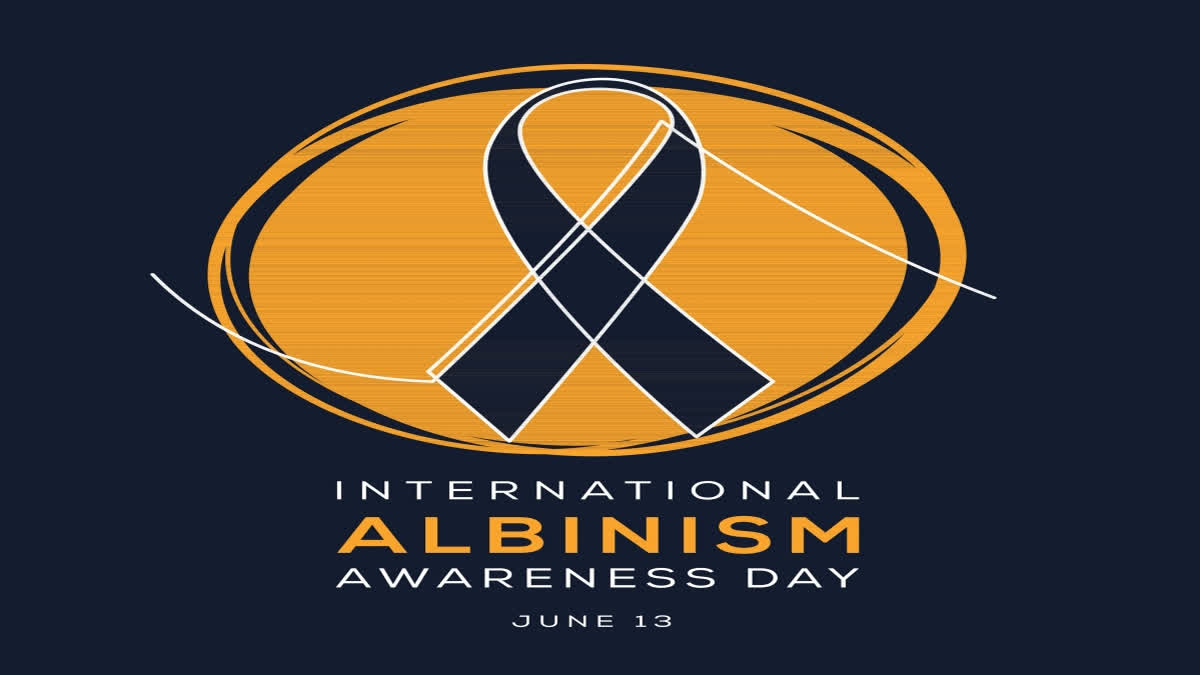When someone has albinism, their body has trouble creating pigment. Pigment is the material in the body that produces colour. People with albinism have a reduced amount or absence of pigment in their eyes, hair and skin. This year is special as it marks a decade since the launch of International Albinism Awareness Day and to observe this day, the theme for this year’ has been selected as “10 years of IAAD: A decade of collective progress”.
This theme invites us to: Celebrate the strides made within the movement, with renewed commitment for the future; Highlight the tireless efforts of albinism groups from around the world; Reflect on the continued legal, policy and practical changes still required to ensure the full and equal enjoyment of rights by persons with albinism
What is Albinism? A person with albinism, an inherited condition, will have extremely pale skin, hair, and eyes. It occurs as a result of their bodies having less melanin than normal. Skin, hair, and eyes get their color from melanin. With the exception of eye issues, the majority of albinos are in good health.
There are two basic types of albinism, both of which cause vision problems, including low vision. One type of albinism is called oculocutaneous albinism or OCA. OCA causes someone to have decreased pigment in the eyes, hair, and skin.
The second type of albinism is called ocular albinism. Ocular albinism mainly affects the eyes. The skin and hair are of normal or near-normal color. Because a child with ocular albinism does not have any outward difference in appearance, eye problems may be the first symptoms of albinism.
Important facts about Albinism :
- Albinism is a genetic condition inherited from both parents that occurs worldwide, regardless of ethnicity or gender.
- The common lack of melanin pigment in the hair, skin and eyes of people with albinism causes vulnerability to sun exposure, which can lead to skin cancer and severe visual impairment.
- As many as 1 in 5,000 people in Sub-Saharan Africa and 1 in 20,000 people in Europe and North America have albinism.
- In some countries people with albinism suffer discrimination, poverty, stigma, violence and even killings.
- In some countries, women who give birth to children with albinism are repudiated by their husbands, and their children abandoned or the victims of infanticide.
- The movie industry has seldom portrayed people with albinism accurately, preferring to depict them as villains, demons or freaks of nature.
- Violence against people with albinism is largely met by social silence and indifference, and is seldom followed by investigations or the prosecution of perpetrators.
History of International Albinism Awareness Day: On December 18, 2014, the United Nations’ General Assembly adopted a resolution establishing June 13th as International Albinism Awareness Day. This historic resolution confirmed the global focus on albinism advocacy. NOAH joins with the worldwide albinism community in encouraging everyone to celebrate and promote albinism awareness on June 13th each year.
The late Ambassador of the Mission of Somalia to the U.N., Geneva, Yusuf Mohamed Ismail Bari-Bari, led the effort to pass the resolution in cooperation with Under the Same Sun, an organization that promotes and protects the rights of people with albinism, particularly in Africa. Shortly thereafter, NOAH participated in a U.N. “side event” to celebrate the adoption of the resolution. The late Excellency Bari-Bari made opening and closing remarks at the event, which included sharing a story with Pope Francis in which he informed the Pontiff of the atrocities committed against people with albinism in Africa. Many other dignitaries also attended the event, and each made brief statements in support of the resolution. These attendees included representatives from the U.N. delegations from Italy, Israel, Canada and the United States, the U.N. Special Representative on Violence against Children, a representative from UNICEF, and several key individuals in the albinism community.
What causes albinism? Albinism is caused by mutations in specific genes that are responsible for melanin production.
Is albinism genetic? Yes, albinism is passed down (inherited) through families. People are born with albinism when they inherit an albinism gene from their parents. In oculocutaneous albinism, both parents must carry an albinism gene for their child to be born with albinism. The child has a 1 in 4 chance of being born with albinism. If just one parent has an albinism gene, the child won’t have oculocutaneous albinism. But they’ll have a 50% chance of being a carrier of the gene themselves.
What are the symptoms of albinism? People with albinism may experience the following symptoms:
- Very pale skin, hair and eyes.
- Patches of missing skin pigment.
- Crossed eyes (strabismus).
- Rapid eye movements (nystagmus).
- Vision problems.
- Light sensitivity (photophobia).
How is albinism diagnosed? Your healthcare provider may do a physical exam and examine your skin, hair and eyes. However, a genetic test will provide the most accurate results and help determine which gene is mutated. This DNA test will help determine which type of albinism you have.
Management and Treatment: There is no cure for albinism. You must manage the condition by being vigilant about sun protection. You can protect your skin, hair and eyes by:
- Staying out of the sun.
- Wearing sunglasses.
- Covering up with sun-protective clothing.
- Wearing hats.
- Applying sunscreen regularly.
- If you have crossed eyes (strabismus), a surgeon may be able to correct the issue with surgery.
Prevention: Albinism is an inherited condition. People with a family history of albinism should consider genetic counseling.
Albinism disease and treatment in India: Albinism in India is still a misunderstood condition. They often face social and family discrimination because of their different appearance. People address them as '‘Angrez’ (British) because of their pale skin. Finding a job is tough when people label them as unnatural.
The process of diagnosing albinism may involve:
- An ophthalmologist or the eye specialist will diagnose albinism by conducting tests which include:
- Physical exam
- Description of the changes in the pigmentation
- Exam of eyes
- Assessment of nystagmus, strabismus, photophobia
- Comparison of the person’s pigmentation with other family members
- Albinism Treatment
- Albinism being a genetic disorder has limited treatment. However, it is necessary to take proper care of the eyes and skin. A person suffering from albinism is advised to wear prescription lenses and also needs to undertake an annual eye test and the screening of skin to prevent the risk of skin cancer.
Newer treatments: A 2021 review states that some of the newer treatments for albinism may include drugs such as l-dihydroxyphenylalanine and nitisinone. Researchers from 2020Trusted Source suggested that administering nitisinone to mice or humans with certain forms of albinism had led to increased circulating tyrosine levels, an action that can cause increased pigmentation. However, a small 2019 study found the drug may not increase pigmentation in the eye itself.
Further studies in humans are necessary to determine the effects of these newer drugs, as they may be a promising treatment for ocular albinism.
10 Most Famous People with Albino:
- Salif Keita: Salif Keïta is a Malian singer-songwriter, referred to as the “Golden Voice of Africa”. He is a member of the Keita royal family of Mali. He was cast out by his parents due to his albinism, Keita rose to be one of Mali’s biggest stars, bringing traditional African rhythms and instruments to a broader audience.
- Johnny Winter: Blues icon Johnny Winter was another famous albino person who made his mark in the world of music. Winter was known for his high-energy blues-rock albums and live performances in the late 1960s and 1970s
- Connie Chiu: Connie Chiu is a fashion model and jazz musician known for being the world’s first fashion model with albinism. Chiu was born in British Hong Kong and grew up in Kowloon. The fourth child in a Chinese family, she is the only one born with albinism.
- Thando Hopa: Thando Hopa is a South African model, activist, and lawyer. She is the first woman with albinism to be on the cover of Vogue.
- Carlos Enrique Estremera Colon: Carlos Enrique Estremera Colón was a Puerto Rican Salsa singer who was a native of Santurce, Puerto Rico.. Estremera, was albino, and billed as “El Cano''.
- Yellowman: Born Winston Foster, Yellowman is an accomplished Jamaican reggae and dancehall deejay. Also known as King Yellowman, the musician was massive in the 80s, releasing close to 30 albums and over 40 singles. His upbringing at the Maxfield Home orphanage in Kingston and being albino in Jamaica were two obstacles that he overcame and went on to be (at one time) the biggest reggae artist since Bob Marley.
- Govinda Rao Harishankar: Govinda Rao Harishankar, (India, June 10, 1958 in Chennai – February 11, 2002 in Chennai) was an Indian player of the kanjira.“The Sunflower” is 17 min short film which revolves around the subject of albinism and how our society is apathetic and inhuman to persons with this skin condition. The film is made as a tribute to Govindarao Harishankar – The Khanjira-Drummer Legend, who was also Albino. This master of percussions named “Khanjira” was honoured.
- Hermeto Pascoal: Hermeto Pascoal is one of the most instantly recognizable musicians in the world, Pascoal, an albino who is also affected with strabismus and is legally blind
- Shaun Ross: Shaun Ross is an American model, recording artist, and actor. He is known for his work in the fashion world as the first professional male model with the congenital disorder albinism
- Victor Varnado: Victor Varnado is an American stand-up comedian and actor who was born legally blind due to his albinism. Varnado’s career in acting began with his roles in various films like End of Days (1999), the drama Julien Donkey-Boy (1999) with Ewen Bremner and The Adventures of Pluto Nash (2002). He also appeared in the comedy A Guy Thing (2003) with Jason Lee.
International Albinism Awareness Day celebrations are necessary to continue the fight for albino people's human rights and condemn such attacks. This day provides an opportunity to educate the general public and fight against misconceptions about albinism. It helps bring issues to light about the hereditary condition, its causes, and the difficulties looked by people with albinism. By eliminating fantasies and advancing precise data, IAAD adds to lessening stigma, discrimination, and prejudice against individuals with albinism.







